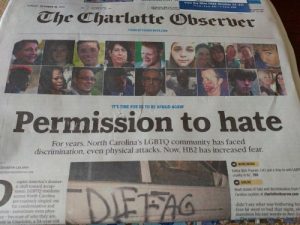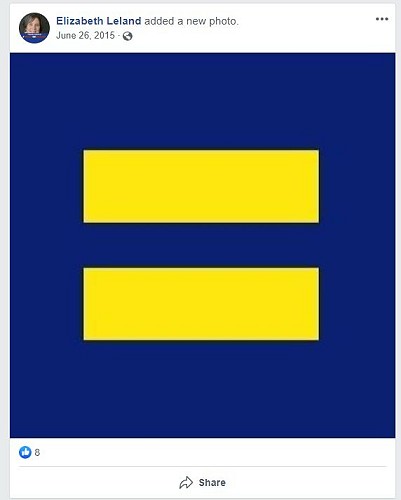Charlotte Observer Wages Total War On HB2 And Their Journalistic Standards

It’s not exactly a secret that the Charlotte Observer opposes HB2. They’ve run countless “objective” pieces on it since its late March passage as well as numerous haughty editorials decrying the law known nationwide now as the “bathroom bill.” They’ve also denounced its proponents – which include victims of sexual assault and rape – as “bigots” fighting against “imaginary threats/ghosts” who need to get over their “discomfort” at the thought of male genitalia in their locker rooms.
So imagine my non-surprise to see the front page of the Sunday, October 16 edition of the paper. “Permission to hate” screamed out from above the fold, and the photos of people from the LGBTQ community above it – some of them bloodied and bruised – drew you in like magnets. They made for compelling subjects in the piece, especially if you’re someone opposed to HB2 and were looking for a little confirmation bias in your local paper to start your day. The article had actually been published several days earlier in the online edition. Apparently the editors felt it was such a captivating piece of work that it deserved prominent Sunday space – as well as a front page story on their Insight section.
“Permission to hate” was such comprehensive piece that it took up 3 full pages in section A, plus the half page on page one. Their companion piece to it was an online page with links where LGBTQ people from 50 counties in North Carolina told their stories of alleged discrimination and/or intimidation – and the paper is sure there are more where that came from, which is why they encouraged readers to share their own stories, presumably so they can start a database for pre-HB2 and post-HB2 incidents.
I suspect the editors believed most people wouldn’t click on the links contained within the “60 stories from 50 counties” companion piece, and they were probably correct in doing so. It’s a lot to sift through. But I did review several of the links and many of them not only didn’t prove “discrimination and intimidation” but there were several that appeared not to be substantiated nor verifiable.
In other words, they took the person at their word that what they said happened happened. This is not to suggest that everyone they talked to lied – there’s no doubt that harassment and violence occurs against members of the LGBTQ community, as it does others – but you have to factor in the possibility that some could be embellished or may not be true. Fake hate crimes reports are not exactly uncommon anymore.
It’s the job of journalists to look beyond what someone tells them to see if their story passes the smell test. In many instances in this piece, that didn’t happen. And – as noted earlier – some of the stories do not fit the narrative, which means the paper (deliberately?) mislead its readers in order to inflate its numbers.
Let’s look at a few county examples.
Transylvania: After HB2, restaurant’s move to unisex bathrooms lost ”“ and gained ”“ customers
There is literally nothing in this story about intimidation or discrimination. It talks about customers who no longer visit the restaurant due to safety and privacy concerns. The end.
Scotland: Print shop wouldn’t do wedding invitations for female couple
The owner of the store, now retired, is a Baptist minister who was exercising his religious rights. He didn’t refuse to serve the couple outright. He refused to provide that particular service, much in the same way an Islamic butcher might refuse to provide pork.
Pamlico: Church chose not to renew Boy Scouts charter after vote to allow gay members
Homosexuality is a sin, according to the Bible. Some churches view the Boy Scouts decision as an endorsement of sin. End of story.
Wilkes: Man says he lobbied for 3 days until county lowered flags after Orlando shooting
Apparently a county’s oversight of lowering their flags after the Orlando shooting is “discrimination.” Okay.
Franklin: At 68, transgender man nervous for first time to use public bathroom
Transgender man worried he will face discrimination and intimidation. There is nothing in the story about whether he faced it before HB2.
Davidson: Two women say they were accused by an attendant of being in wrong bathroom at I-85 stop
Unsubstantiated.
Richmond: Gay couple stopped for ice cream. Owner told them to stop holding hands
Unsubstantiated.
Yancey (VIDEO): Snub at store causes man to recall long ago days of being called names, bullied
Unsubstantiated.
Johnston: After man maligned District 2 candidate, transgender woman told him ”“ I’m the candidate
Unsubstantiated.
Why is it important to note several of the stories on their website are unsubstantiated? Because the Charlotte Observer apparently treats unsubstantiated stories from the LGBTQ community much differently than they do substantiated stories about sexual victimization by predators in women’s facilities like bathrooms and locker rooms.
This Politifact NC “fact check” from April 6th weighed in on the assertions made by HB2 proponents that opening up women’s facilities to anyone increases the chances they’ll be sexually victimized. After searching for instances of women being victimized in America by men pretending to be women, here’s what fact checker Will Doran wrote (emphasis added):
Again, though, none of those crimes occurred in places where biological men would have had any legal claim to be in a women’s room by virtue of being a transgender woman.
The blogs did identify a few examples of alleged criminal activity having taken place under the guise of transgender-friendly bathrooms laws, but we couldn’t find proof of any convictions in those cases.
@NotInCharlotte If there are convictions in the future that you hear of, please let me know and I will update what I wrote.
Will Doran (@will_doran) April 6, 2016
@CanicaSteve @ndrewL7 We gave some weight to those arrests, hence Mostly True. Haven’t heard of convictions yet; innocent til proven guilty.
PolitiFact NC (@PolitiFactNC) April 2, 2016
To break it down: Unsubstantiated stories told by LGBTQ citizens on alleged harassment should be believed without question and treated with the utmost reverence, but actual cases involving men dressed as women to gain access to them in order to do harm don’t count, because as of the writing of their fact check there were no convictions of those cases.
Wow.
These are the duplicitous standards at the Charlotte Observer. Narratives can be crafted from unverifiable stories but not from confirmed cases – depending on what side of the issue they’re on on any given day.
Also, the legitimacy of the claims in a piece that’s supposed to be “objective” and unbiased shouldn’t be based on the personal opinions of the writer, in this case, Elizabeth Leland – a proponent of LGBTQ equality.

The paper can’t have it both ways. Either a person’s story should be taken at face value without some investigative digging or it shouldn’t. And if you’re going to count unsubstantiated stories as concrete “evidence” of something, you should count confirmed stories about crimes that have been alleged to have happened – even if there haven’t yet been any convictions. Which will it be, Charlotte Observer?
